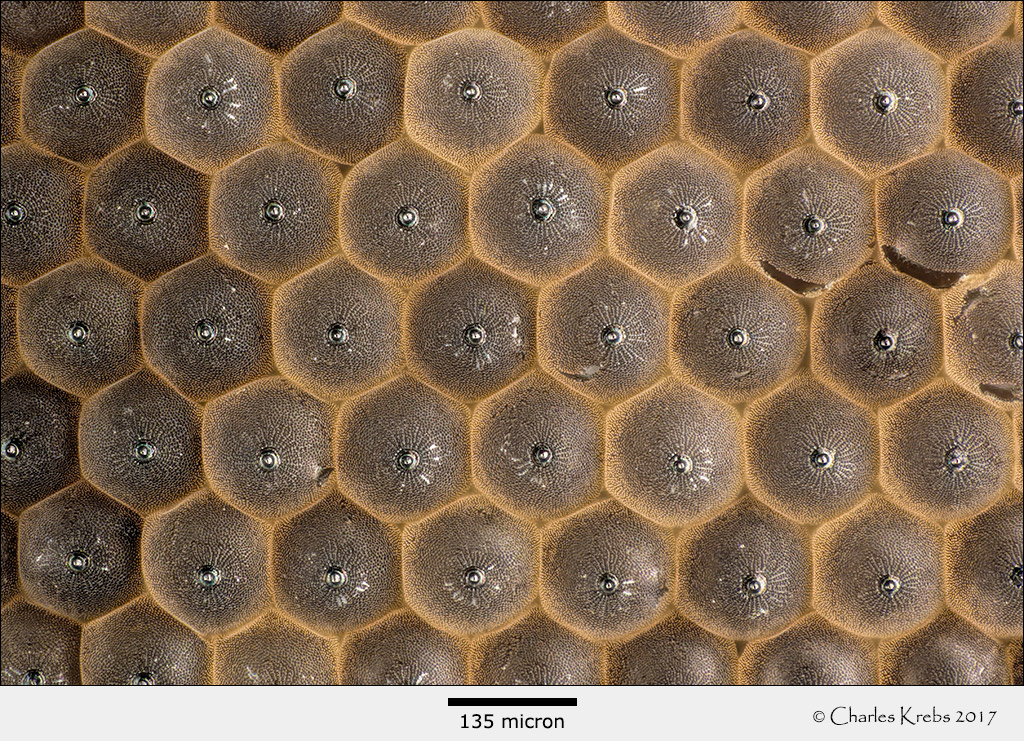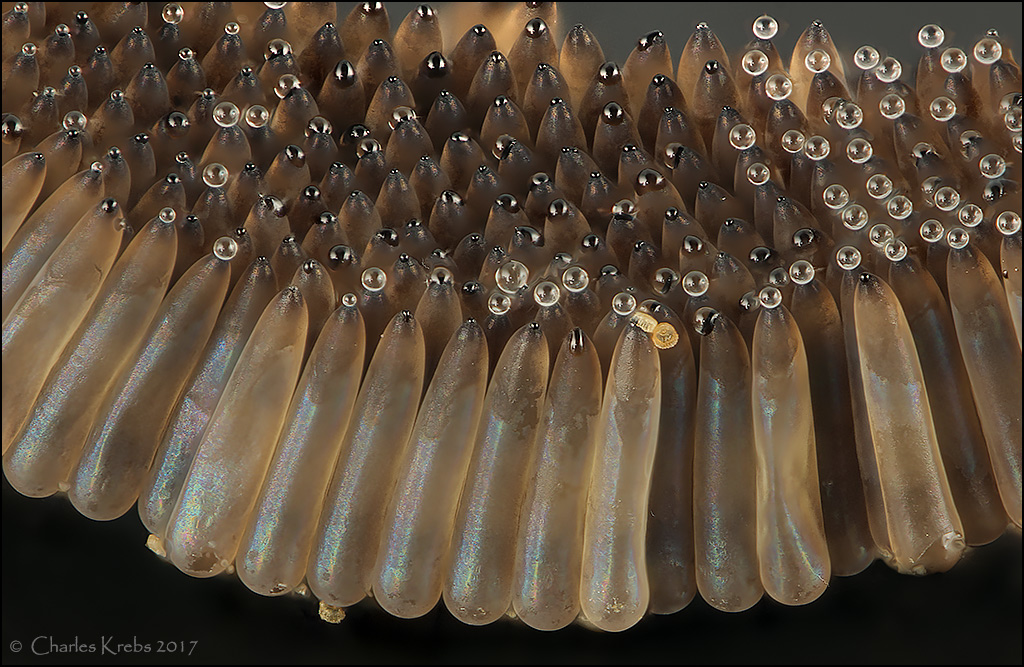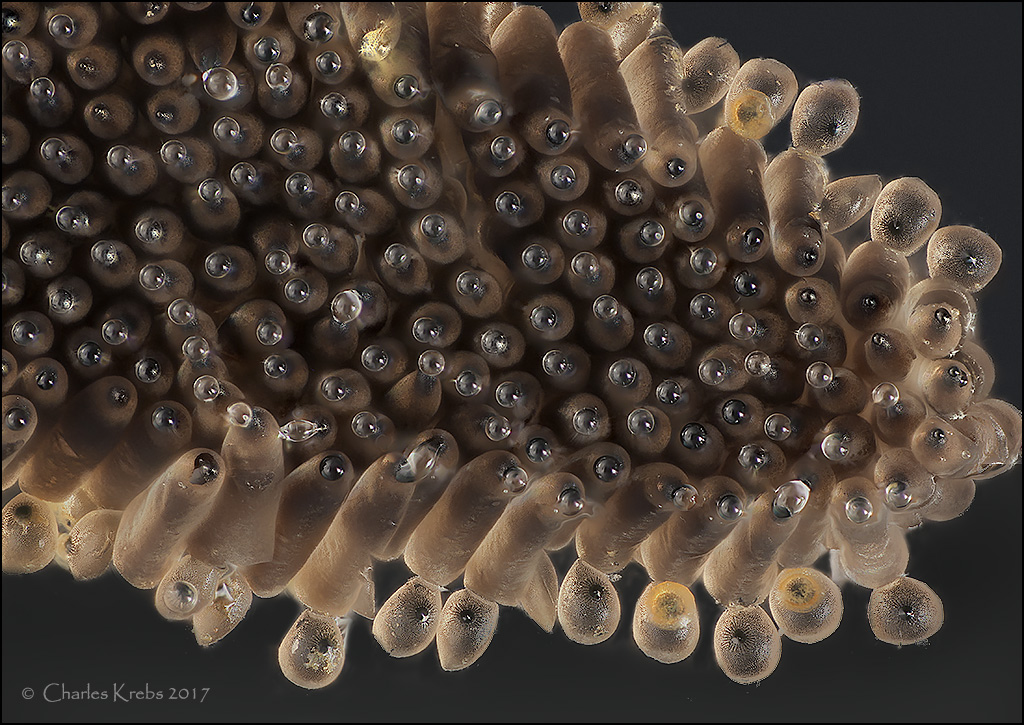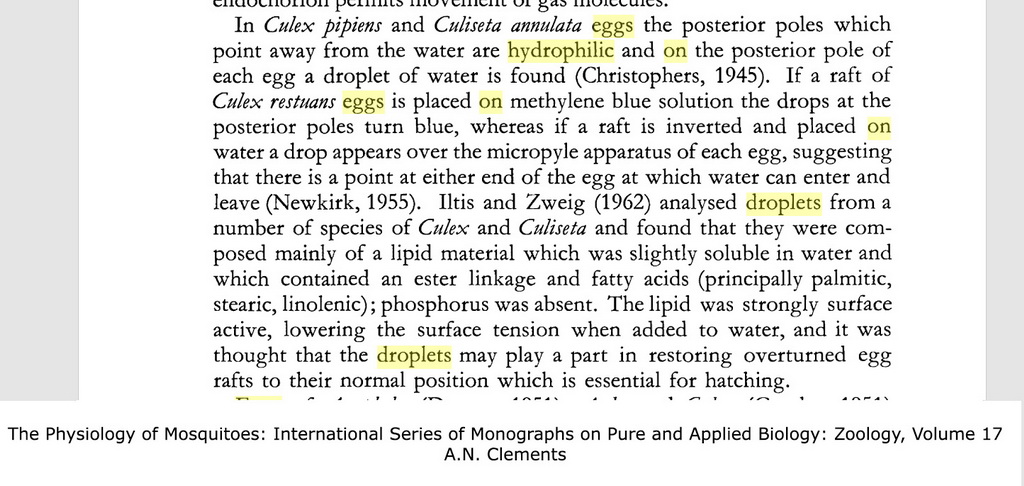
What have we here? (quiz)
Moderators: rjlittlefield, ChrisR, Chris S., Pau
- Charles Krebs
- Posts: 5865
- Joined: Tue Aug 01, 2006 8:02 pm
- Location: Issaquah, WA USA
- Contact:
- Cactusdave
- Posts: 1631
- Joined: Tue Jun 09, 2009 12:40 pm
- Location: Bromley, Kent, UK
I agree with Jacek. Egg raft of a midge or mosquito. In the UK it would probably be what we would call a 'gnat'. The structure at the apex is quite distinctive. Would it be called an 'operculum'? I believe this is where the larva emerges.
Leitz Ortholux 1, Zeiss standard, Nikon Diaphot inverted, Canon photographic gear
- Charles Krebs
- Posts: 5865
- Joined: Tue Aug 01, 2006 8:02 pm
- Location: Issaquah, WA USA
- Contact:
One reason I thought this might be an interesting "quiz" is because we very rarely see pictures of this subject from this angle. It is indeed a raft of mosquito eggs, but the picture above is of the bottom of the raft which is always in contact with the water surface. The hexagonal ends of each egg (seen above looking a great deal like an unusual compound eye) become the exit "hatches" for the larva.
Below are two more images of these eggs, taken from the more commonly seen angles.


I have photographed these once before ( http://www.photomacrography.net/forum/v ... hp?t=24527 ) but this time there was another feature present that I had not seen before. Note the small droplets perched atop most of the eggs in the first shot in this post. At first I thought these were simple water droplets, perhaps deposited from my handling to transfer the eggs to a slide. But this was not the case. These drops contain very strong surface-active substances. Initially I had the egg raft in a petri dish with pond water that had a large amount of very fine silt/debris floating on the surface. I carefully touched a needle tip to a droplet, transferring some of it to the tip of the needle. When I then gently touched the needle tip to the waters surface all of the surface particles immediately and rapidly spread out away from the needle. This left a significant circular area of clear water around the tip of the needle. Considering the tiny amount of the droplet transferred on the tip of the needle it was actually pretty impressive how quickly and how far the surface debris dispersed away from the tip. It always fascinates me when I see something like this and immediately begin to ponder the purpose this might serve. Although it was not an exhaustive search, I only came across a couple of references to such drops, their contents, and conjecture as to their purpose.

The research by W. G. Iltis and Gunter Zweig referenced above can be purchased and downloaded here (I'm curious about it, but not $42 worth of curious ):
):
https://academic.oup.com/aesa/article-a ... m=fulltext
From:
https://www.ncbi.nlm.nih.gov/pmc/articles/PMC5198213/
Mosquito Oviposition Behavior and Vector Control
Jonathan F. Day
"In some cases, gravid females use the presence or absence of mosquito eggs to evaluate a potential oviposition site. Some eggs are deposited with a volatile aggregation pheromone contained in an apical droplet. For example, Cx. quinquefasciatus females produce an apical droplet that accompanies each egg as it is deposited. The major pheromone component in Cx. quinquefasciatus apical droplets is (?)-(5R,6S)-6-acetoxy-5-hexadecanolide. This substance induces gravid females to oviposit around the pheromone source. The pheromone was successfully synthesized in the laboratory [42] where it was observed that a shortening of the alkyl chain made it less attractive while perfluorination of the alkyl chain or substitution of the acetoxy groups with the trifluoroacetoxy group resulted in active pheromone analogues. Once the pheromone was synthesized it could be manufactured in large quantities. It was formulated into tablets that were field tested in Kenya for their ability to concentrate gravid mosquitoes into specific production sites where larvae were successfully controlled. The effect of Culex apical droplets is nonspecific. For example, Cx. quinquefasciatus will display a positive oviposition response when exposed to apical droplet pheromones produced by Cx. pipiens molestus and Cx. tarsalis Coquillett. Similar aggregation pheromones have been reported for a number of mosquitoes that deposit egg rafts including species of Culex, Culiseta, and Uranotaenia [43,44]."
Below are two more images of these eggs, taken from the more commonly seen angles.


I have photographed these once before ( http://www.photomacrography.net/forum/v ... hp?t=24527 ) but this time there was another feature present that I had not seen before. Note the small droplets perched atop most of the eggs in the first shot in this post. At first I thought these were simple water droplets, perhaps deposited from my handling to transfer the eggs to a slide. But this was not the case. These drops contain very strong surface-active substances. Initially I had the egg raft in a petri dish with pond water that had a large amount of very fine silt/debris floating on the surface. I carefully touched a needle tip to a droplet, transferring some of it to the tip of the needle. When I then gently touched the needle tip to the waters surface all of the surface particles immediately and rapidly spread out away from the needle. This left a significant circular area of clear water around the tip of the needle. Considering the tiny amount of the droplet transferred on the tip of the needle it was actually pretty impressive how quickly and how far the surface debris dispersed away from the tip. It always fascinates me when I see something like this and immediately begin to ponder the purpose this might serve. Although it was not an exhaustive search, I only came across a couple of references to such drops, their contents, and conjecture as to their purpose.

The research by W. G. Iltis and Gunter Zweig referenced above can be purchased and downloaded here (I'm curious about it, but not $42 worth of curious
https://academic.oup.com/aesa/article-a ... m=fulltext
From:
https://www.ncbi.nlm.nih.gov/pmc/articles/PMC5198213/
Mosquito Oviposition Behavior and Vector Control
Jonathan F. Day
"In some cases, gravid females use the presence or absence of mosquito eggs to evaluate a potential oviposition site. Some eggs are deposited with a volatile aggregation pheromone contained in an apical droplet. For example, Cx. quinquefasciatus females produce an apical droplet that accompanies each egg as it is deposited. The major pheromone component in Cx. quinquefasciatus apical droplets is (?)-(5R,6S)-6-acetoxy-5-hexadecanolide. This substance induces gravid females to oviposit around the pheromone source. The pheromone was successfully synthesized in the laboratory [42] where it was observed that a shortening of the alkyl chain made it less attractive while perfluorination of the alkyl chain or substitution of the acetoxy groups with the trifluoroacetoxy group resulted in active pheromone analogues. Once the pheromone was synthesized it could be manufactured in large quantities. It was formulated into tablets that were field tested in Kenya for their ability to concentrate gravid mosquitoes into specific production sites where larvae were successfully controlled. The effect of Culex apical droplets is nonspecific. For example, Cx. quinquefasciatus will display a positive oviposition response when exposed to apical droplet pheromones produced by Cx. pipiens molestus and Cx. tarsalis Coquillett. Similar aggregation pheromones have been reported for a number of mosquitoes that deposit egg rafts including species of Culex, Culiseta, and Uranotaenia [43,44]."
- carlos.uruguay
- Posts: 5358
- Joined: Thu Feb 23, 2012 8:05 pm
- Location: Uruguay - Montevideo - America del Sur
- Contact:
-
fpelectronica
- Posts: 1808
- Joined: Fri Feb 19, 2010 3:56 pm
- Location: España
Very interesting - and as usual - very good pictures!
- Jörgen
- Jörgen
Jörgen Hellberg, my webbsite www.hellberg.photo

